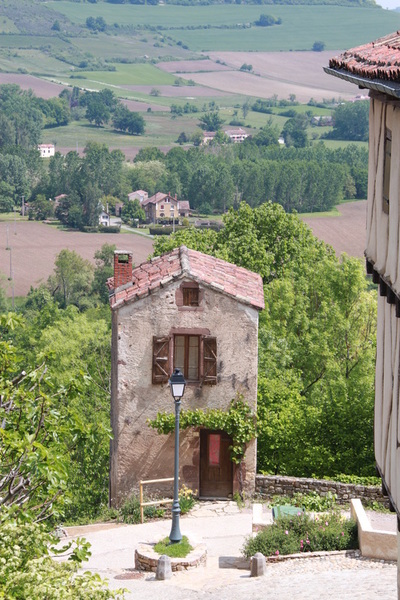Reference : Wikipedia
Cordes-sur-Ciel (Occitan: Còrdas) is a commune in the Tarn department in southern France. The fortified town was built in 1222 by Raimon VII, the Count of Toulouse, who, though not a Cathar himself, tolerated the heresy. The village is now a popular tourist spot. Until recently the town's name was Cordes, a word thought to come from the Indo-European root "corte" meaning "rocky heights."
In 1222, Cordes received its charter to become a "bastide" from the Count of Toulouse. It is generally considered to be the first of the bastides of SW france. Bastides were "new towns" originally conceived to resettle and pacify people caught up in the Albigensian Crusade. Though not fortified, bastides were often built in defensible locations. It was built between 1222 and 1229 to protect the scattered population of the area from conflict. It was made to replace the village of Saint-Marcel, which was burnt down by the troops of Simon de Montfort in 1215, during the Northern Baron's crusade against the Albigensians.
Cordes-sur-Ciel (Occitan: Còrdas) is a commune in the Tarn department in southern France. The fortified town was built in 1222 by Raimon VII, the Count of Toulouse, who, though not a Cathar himself, tolerated the heresy. The village is now a popular tourist spot. Until recently the town's name was Cordes, a word thought to come from the Indo-European root "corte" meaning "rocky heights."
In 1222, Cordes received its charter to become a "bastide" from the Count of Toulouse. It is generally considered to be the first of the bastides of SW france. Bastides were "new towns" originally conceived to resettle and pacify people caught up in the Albigensian Crusade. Though not fortified, bastides were often built in defensible locations. It was built between 1222 and 1229 to protect the scattered population of the area from conflict. It was made to replace the village of Saint-Marcel, which was burnt down by the troops of Simon de Montfort in 1215, during the Northern Baron's crusade against the Albigensians.
In the 1229 Treaty of Paris Raymond VII of Toulouse conceded defeat to Louis IX of France. In 1241, Jeanne, the Count of Toulouse, married Alphonse II the brother of Louis IX and the Count of Poitiers. As a result, Cordes became a part of France in 1271 without ever having been militarily conquered. In 1436 Rodrigo de Villandrando pillaged Cordes as part of the Hundred Years' War. The citizens of Cordes, having built their homes within the original 13th century ramparts, later escaped heavy damage during the religious wars at the end of the 16th century. As a result some excellent examples of 13th and 14th century gothic architecture have been preserved.
Modern history
Cordes was revived in the mid-20th century, by artists and other visitors who noticed the town's beauty. Albert Camus visited it in the 1950s and remarked that “In Cordes, everything is beautiful, even regret”. In 1993 Cordes was renamed Cordes-sur-Ciel to reflect the town's site on a hill above the clouds that cover the valley below.
Modern history
Cordes was revived in the mid-20th century, by artists and other visitors who noticed the town's beauty. Albert Camus visited it in the 1950s and remarked that “In Cordes, everything is beautiful, even regret”. In 1993 Cordes was renamed Cordes-sur-Ciel to reflect the town's site on a hill above the clouds that cover the valley below.





